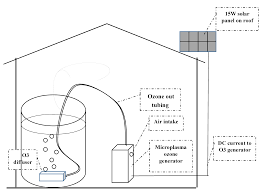EPA Method 1660
Ozonation is widely used in high-income countries for water disinfection in centralized treatment facilities. New microplasma technology has reduced the energy requirements for ozone generation dramatically, such that a 15-watt solar panel is sufficient to produce small quantities of ozone. This technology has not been used previously for point-of-use drinking water treatment. We conducted a series of assessments of this technology, both in the laboratory and in homes of residents of a village in western Kenya, to estimate system efficacy and to determine if the solar-powered point-of-use water ozonation system appears safe and acceptable to end-users.
In the laboratory, two hours of point-of-use ozonation reduced E. coli in 120 L of wastewater by a mean (standard deviation) of 2.3 (0.84) log-orders of magnitude and F+ coliphage by 1.54 (0.72). Based on laboratory efficacy, 10 families in Western Kenya used the system to treat 20 L of household stored water for two hours on a daily basis for eight weeks. Household stored water E. coli concentrations of >1000 most probable number (MPN)/100 mL were reduced by 1.56 (0.96) log removal value (LRV).
No participants experienced symptoms of respiratory or mucous membrane irritation. Focus group research indicated that families who used the system for eight weeks had very favorable perceptions of the system, in part because it allowed them to charge mobile phones. Drinking water ozonation using microplasma technology may be a sustainable point-of-use treatment method, although system optimization and evaluations in other settings would be needed.

There are no products listed under this category.